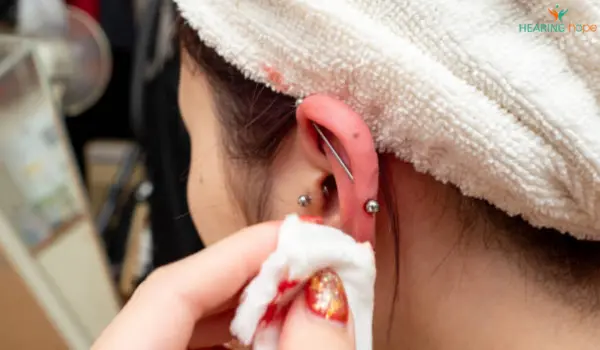
Ear Bleeding – Causes, Symptoms, Remedies & When to See a Doctor
If you’re experiencing ear bleeding or noticing blood in or around your ear, it can be alarming. While some cases are minor, others may need medical care. This guide helps you understand what causes ear bleeding, how to treat it, and when to see a doctor.
Ear bleeding can happen for different reasons. It may be due to an injury, infection, or even something as simple as cleaning the ear the wrong way. Sometimes, the bleeding comes with pain, fluid discharge, or hearing problems. Knowing the cause can help you decide what to do next.
In this blog, we’ll break down the common causes of ear bleeding, what symptoms to watch for, and what treatments are available. You’ll also find first-aid tips, prevention advice, and answers to the most asked questions. Whether it’s a small scratch or a sign of infection, this guide will give you the facts you need to protect your ear health.
What Is Ear Bleeding?
Ear bleeding refers to the presence of blood coming from inside the ear canal, the outer ear, or surrounding areas. It can range from a small spot of blood on a tissue to a more serious flow of blood. The color might be bright red or mixed with pus or fluid.
Quick Facts:
Type of Bleeding | Possible Cause | Urgency |
Light bleeding | Minor injury or scratch | Low |
Mixed with fluid | Ear infection or eardrum issue | Medium to High |
Heavy bleeding | Trauma or a ruptured eardrum | High – see doctor |
Common Causes of Ear Bleeding
Understanding the cause is key to treatment. Below are the main reasons you may experience bleeding from the ear:
External Causes
- Using sharp objects like cotton buds or hairpins to clean ears
- Scratching due to itchiness or dry skin
- Sunburns or skin infections on the outer ear
- Insect bites around the ear area
- A bug in the ear can cause discomfort, scratching, or injury, which may lead to bleeding
Internal Causes
- Ruptured eardrum due to pressure, loud sounds, or infections.
- Middle ear infections (Otitis Media) – causes pus, pain, and sometimes bleeding.
- Foreign objects inserted by children or accidentally during cleaning.
Medical Conditions
- Mastoiditis – infection of the bone behind the ear.
- Polyps or tumors in the ear canal or middle ear.
- Severe sinus or throat infections spreading to the ear.
Symptoms That May Come With Ear Bleeding
Along with visible blood, you might also notice these signs:
- Ear pain or sharp pressure
- Fluid or pus coming out
- Feeling dizzy or off balance
- Muffled hearing or ringing sounds (tinnitus)
- Swelling around the ear
- Headache or fever – in some cases, an ear infection can cause a headache, especially when the pressure spreads to nearby areas of the head
If you experience multiple symptoms, it may be a sign of something more serious.
When Is Ear Bleeding Serious?
Not all cases need emergency care, but some do. Here are warning signs that require immediate medical attention:
Seek Help If You Notice:
- Bleeding that doesn’t stop after a few hours
- Bleeding with severe ear pain
- Blood with yellow or green pus
- Hearing loss or ringing
- Fever over 100.4°F (38°C)
- Dizziness or confusion
How to Prevent Ear Bleeding
Simple Tips to Keep Your Ears Safe:
- Don’t insert anything into your ears—not even cotton swabs
- Use ear protection in loud places (concerts, construction, etc).
- Treat infections early to prevent them from spreading
- Avoid using sharp objects for cleaning or scratching the ear
- Manage allergies and colds before they lead to ear problems
First Aid for Ear Bleeding
If you see blood from the ear and it’s not a medical emergency, you can take these steps at home:
What to Do:
- Stay calm and keep your head upright.
- Gently clean the outer ear using a soft cloth—don’t insert anything inside.
- Apply a cold compress near the ear to reduce swelling or bleeding.
- Avoid putting drops or ointments unless advised by a doctor.
- Call a doctor if the bleeding continues or pain increases.
When to See a Doctor
If you’re unsure whether your ear bleeding is serious or not, it’s always better to play it safe. Here are signs you need medical help:
- Blood mixed with pus or bad smell
- Continuous pain or blocked hearing
- Feeling dizzy or losing balance
- You’re unsure what caused the bleeding
You can also schedule a Hearing Test in Delhi to check for any internal ear issues or hearing damage.
Conclusion
Ear bleeding can be scary, but in many cases, it’s treatable and not dangerous. By understanding the causes—whether it’s an infection, injury, or underlying condition—you can take the right steps quickly. From at-home care to professional treatment, there are many options to protect your hearing.
Always stay alert to warning signs like fever, pus, or pain. And when in doubt, consult a doctor or take a Hearing Test in Delhi to rule out serious problems.
Frequently Asked Questions
Stay calm and avoid inserting anything into the ear. Gently wipe away any visible blood and contact a pediatrician immediately. Children often insert objects into their ears or get infections that can cause bleeding.
Yes, in some cases, ear bleeding may occur without pain—especially if it’s due to a minor scratch or a ruptured eardrum. However, pain-free bleeding can still be a sign of something serious and should be checked.
Common signs include sudden ear pain, hearing loss, ringing in the ear (tinnitus), and sometimes blood or fluid discharge. Only a doctor can confirm a rupture using a physical exam.
It’s rare, but persistent or unexplained ear bleeding could be related to tumors or polyps in the ear canal or middle ear. If the bleeding doesn’t stop or comes with hearing loss, it’s important to see a doctor for a proper check-up.
Yes. Avoid inserting objects into your ear, treat infections early, use ear protection in noisy areas, and go for regular ear check-ups—especially if you’ve had ear problems before.
Dr. Harshi, is an accomplished Audiologist with extensive expertise in treating individuals with hearing impairments.

